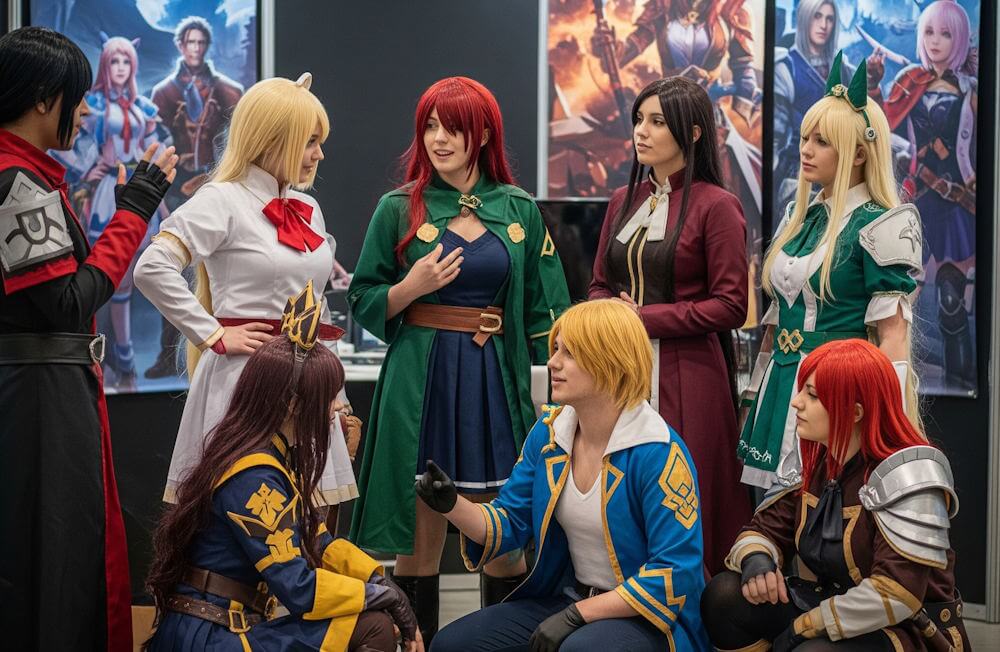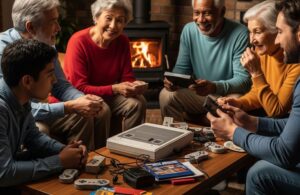Introduction to Cosplay and Gaming Culture
Cosplay, a portmanteau of “costume” and “play,” has gained remarkable popularity within various fandoms, particularly among gaming enthusiasts. This creative practice allows fans to embody their favorite characters from video games, anime, movies, and comics, bringing personal expression and social interaction into a shared hobby. The origins of cosplay can be traced back to the 1939 World Science Fiction Convention, where attendees dressed as characters from their cherished stories. However, it was in the late 20th century that cosplay truly flourished, coinciding with the explosive growth of gaming culture.
As video games transitioned from simple pixelated images to immersive 3D worlds and intricate narratives, the desire for deeper engagement surged. This evolution paralleled the rise of cosplay, where fans began to craft detailed costumes and participate in conventions, celebrating the characters they admired. Cosplay events, typically held at gaming conventions, have become a vibrant outlet for fans to showcase their work, meet like-minded individuals, and strengthen their bonds within the gaming community.
Visual representation plays a crucial role in the gaming experience, as it fosters a deeper connection between players and their favorite characters. Cosplay serves as a medium through which gamers can express their passion and creativity, while simultaneously promoting inclusivity within the fandom. Through the wearers’ interpretations, cosplay not only pays homage to beloved characters but also encourages dialogue around themes of identity, appearance, and self-expression within the gaming culture. As such, the significance of cosplay in building strong connections among fans cannot be overstated, as it unites individuals through a shared appreciation for the artistry and storytelling inherent in video games.
The Role of Shared Passion
The world of cosplay is not merely about wearing costumes; it is a vibrant tapestry woven from the threads of shared passion and mutual admiration for games and characters. At the core of this phenomenon lies a deep emotional connection that individuals feel toward their favorite personas, whether they are heroic protagonists, memorable anti-heroes, or whimsical side characters. This emotional resonance sparks the desire to embody these characters through cosplay, creating a strong sense of participation in a collective narrative.
As cosplayers gather, both in physical spaces such as conventions and online platforms, they engage in collaborative efforts that enrich the gaming community. The act of designing and creating costumes often leads to friendships formed through shared brainstorming sessions and skill-building workshops. The joy of presenting a character to the world can create an electrifying atmosphere where individuals feel seen and understood. This sense of validation fosters inclusiveness and encourages personal expression, allowing fans to connect over their shared love for the source material.
Online platforms serve as crucial spaces for these interactions, where cosplayers can share their experiences, tutorials, and finished projects. Social media has become a powerful tool for engagement, facilitating discussions and collaborations that transcend geographic boundaries. Anecdotes from community members reflect how virtual connections have been transformed into real-life friendships. For instance, many cosplayers recount stories of meeting online peers who share their enthusiasm, leading to joint cosplay appearances and creative projects that further solidify their bonds.
Ultimately, the shared passion for cosplay not only strengthens individual ties among fans but also enhances the vibrancy of the gaming community as a whole. By celebrating their beloved characters together, cosplayers nurture an environment where creativity flourishes and friendships deepen, underlining the profound power of connection in the fandom landscape.
Building Connections Through Events and Conventions
Cosplay conventions and events serve as vital hubs for enthusiasts to come together and celebrate their shared interests in gaming and related franchises. These gatherings provide a platform for individuals to showcase their creativity, talent, and passion through their meticulously crafted costumes. By participating in these events, cosplayers not only exhibit their work but also engage with a community that appreciates their efforts, creating valuable in-person connections.
One of the most significant aspects of conventions is the opportunity they offer for interaction. Fans who may have only previously connected online can forge lasting friendships in person, enhancing their sense of belonging within the cosplay community. The atmosphere of camaraderie is palpable at these gatherings; attendees often share tips, ideas, and experiences, enriching each other’s journey into the world of cosplay. Additionally, many conventions host panels and workshops led by industry professionals and seasoned cosplayers, further emphasizing the importance of skill development and networking within the fandom.
Moreover, events and conventions play a crucial role in showcasing the diversity of talent within the community. Cosplayers often take immense pride in their work, highlighting not just their craftsmanship but also the various interpretations of beloved characters from games. This exhibition of creativity not only reinforces individual identity within the fandom but also inspires others to push their boundaries and explore new design techniques. It beckons attendees to appreciate the artistry behind each costume, creating a space where collaboration and innovation thrive.
Ultimately, as fans gather at these conventions, they strengthen the bonds that unite them in their shared love for gaming and cosplay. The relationships formed and the talents celebrated during these events contribute significantly to the overall experience, leaving lasting memories and connections that extend beyond the conventions themselves.
Cosplay as a Form of Expression and Identity
Cosplay has emerged as a dynamic mode of expression within gaming fandoms, enabling fans to immerse themselves in the worlds of their favorite characters. This creative practice allows individuals to adopt costumes and personas that resonate with them, ultimately providing a space for personal identity exploration. Fans often choose characters that reflect their own experiences, aspirations, or attributes, allowing for a deeper connection to their chosen identities. In this way, cosplay becomes not just a hobby but a meaningful avenue for self-discovery.
The inclusivity of cosplay plays a pivotal role in its impact as a form of self-expression. People from diverse backgrounds, genders, body types, and ethnicities participate in this vibrant community, showcasing a variety of interpretations of characters through their unique lenses. This broad spectrum challenges traditional stereotypes often associated with gaming and fandom culture. By defying conventional portrayals of characters, cosplayers carve out space for underrepresented identities, promoting acceptance and support within the community. The varied interpretations foster an understanding that fandom transcends superficial categorization, inviting individuals to celebrate their uniqueness while connecting over common interests.
Additionally, cosplay strengthens bonds among fans, as shared experiences in crafting costumes and attending events provide fertile ground for connection. Participating in cosplay can evoke camaraderie, as many enthusiasts share tips, ideas, and encouragement with one another. This collaborative spirit nurtures a sense of belonging, allowing individuals to feel seen and appreciated within the community. Through social media platforms, cosplayers can leverage their creativity, receiving validation and support from peers worldwide. As such, cosplay emerges not only as an art form but as a bridge that reinforces the bonds of friendship and identity among gaming enthusiasts.
The Impact of Online Communities and Social Media
The rise of digital platforms and social media has significantly transformed the landscape of cosplay and gaming fandoms. These online spaces serve not only as hubs for sharing creativity but also as vital centers for fostering connections among enthusiasts. By allowing individuals to showcase their outfits, share tutorials, and narrate personal experiences, these communities create an enriched environment that transcends geographical barriers. This increase in accessibility has empowered cosplayers to reach wider audiences, enabling them to gain visibility for their work and passion.
Social media platforms like Instagram, Twitter, and TikTok offer momentary glimpses into the vibrant world of cosplay. The instant nature of these platforms facilitates immediate feedback and the exchange of ideas among fans. For instance, hashtags related to cosplay and gaming provide a streamlined method for users to discover content that aligns with their interests. From elaborate costume designs to tutorials on makeup application, these shared resources offer opportunities for learning and inspiration. Moreover, platforms like YouTube feature extensive video guides that can help newcomers navigate the complexities of crafting their first cosplay, ultimately leading to a more inclusive community.
Beyond sharing creative content, online communities often cultivate supportive networks. Affiliations formed in these digital spaces can lead to friendships based on common interests and experiences. Participants frequently engage in discussions around challenges faced in cosplay, sharing advice and encouragement that serve to uplift one another. This sense of camaraderie helps users feel accepted, reducing feelings of isolation that may arise in physical spaces where their passions are less understood. Overall, the impact of online communities and social media in the cosplay and gaming realms cannot be overstated, as they significantly enhance the interaction, creativity, and support within these vibrant fandoms.
Collaboration and Creativity: The Art of Cosplay
Cosplay, short for costume play, serves as a vibrant medium through which fans can express their love for games and characters. At the heart of cosplay is collaboration, which often leads to enhanced creativity and skill-sharing among enthusiasts. Fans come together to craft elaborate costumes that recreate their favorite characters from video games, comics, and films, tapping into a wealth of imagination and resourcefulness.
Within this diverse community, collaboration manifests in various forms. Cosplayers regularly participate in group projects, known as cosplays, where they work collectively to create costumes that reflect a specific theme or game. This process not only strengthens friendships but also improves technical skills—be it sewing, prop-making, or makeup artistry. Workshops and meetups are popular avenues for fans to exchange ideas and techniques, allowing novice cosplayers to learn from more experienced ones.
Additionally, conventions and online platforms provide spaces where cosplayers can showcase their masterpieces and engage with a broader audience. Social media, in particular, has revolutionized the cosplay experience, enabling fans to share their creations and collaborate with others across the globe. By tagging each other in posts and participating in challenges, cosplayers inspire one another, fueling a cycle of creativity that leads to breathtaking designs and performances.
For instance, thematic group cosplays often feature entire casts from a game, uniting individuals who have poured their passion and skills into a shared project. This communal aspect emphasizes storytelling; each costume tells a story that honors the source material while also demonstrating the cosplayers’ distinct artistic flair. Such collaborative endeavors not only enrich the creativity of those involved but also reinforce the community spirit among fandoms, making cosplay a dynamic and inclusive art form.
Overcoming Challenges: Support Systems in Fandoms
Cosplaying can be a fulfilling and creative outlet for individuals, allowing them to express their passion for their favorite games and characters. However, participants often encounter various challenges that can hinder their experience. Criticism, negativity, and the pressure to conform to established standards can be discouraging, leading some to question their commitment to the craft as well as their place within the community.
Negative feedback can come from outside the community, where individuals may not understand the artistic effort that goes into cosplaying. This criticism can tempt aspiring cosplayers to abandon their projects or even to reconsider their involvement in fandoms altogether. Furthermore, the rise of social media amplifies the visibility of these challenges, making public scrutiny more pronounced. Fortunately, the cosplay community is replete with support systems designed to help its members navigate these difficulties.
Supportive networks within fandoms play a critical role in helping cosplayers cope with negativity. These networks can include local cosplay groups, online forums, and social media communities where individuals can share their experiences, receive constructive feedback, and express their creativity without fear of judgment. Esteemed cosplayers often serve as mentors, guiding newer entrants through the challenges they face while fostering an inclusive atmosphere that values individuality over conformity.
In essence, the collaborative spirit inherent in cosplay enables its practitioners to create a robust support system that champions creativity and self-acceptance. By encouraging cosplayers to embrace their unique interpretations of characters, the community cultivates an environment where individuals feel accepted and valued, ultimately reinforcing the bonds of fandoms. Through these collective efforts, challenges are surmounted, giving rise to a more vibrant and welcoming community.
Cosplay Influence on Gaming Companies and Products
Cosplay has emerged as a significant cultural phenomenon within the gaming community, influencing the way gaming companies approach product development and marketing strategies. As fan engagement grows, developers have recognized the value of collaborating with cosplayers to enhance branding and build stronger connections with their audience. This partnership not only strengthens the relationship between fans and creators but also amplifies the reach of gaming products.
Many gaming companies have started directly collaborating with cosplayers to promote their latest releases or expansions. These partnerships often manifest in the form of promotional events, social media campaigns, and appearances at conventions. By showcasing high-quality cosplay, companies can authentically present their characters and stories, attracting more players to their titles. Furthermore, cosplayers often generate user-generated content that effectively promotes games in a way that can resonate with potential players, as it reflects genuine passion and enthusiasm for the characters.
Moreover, the impact of cosplay extends beyond marketing. Game developers frequently monitor the creations of cosplayers to gather insights on character popularity and design preferences. This feedback loop influences product development, leading to more informed choices regarding game mechanics, character designs, and merchandising. In various instances, developers have adjusted their characters based on fan-created content, illustrating the symbiotic relationship between the gaming industry and its community. For instance, character costumes that gain popularity through cosplay can become canonical alternatives, reinforcing the significance of cosplayer input in character evolution.
As the gaming landscape continues to evolve, the closeness between cosplay and the industry is only expected to deepen. The recognition of the role that cosplay plays in shaping gaming products and companies’ marketing strategies underscores a broader trend of valuing community-driven feedback. With ongoing collaboration, the gaming world stands to grow richer, fueled by the passion of its fans and the creativity expressed through cosplay.
Conclusion: Celebrating the Nexus of Cosplay and Gaming Fandoms
In recapitulating the points elucidated throughout this blog post, it becomes evident that cosplay serves as a transformative connection within gaming fandoms. This practice of embodying beloved characters allows fans to interact with their interests on a multifaceted level. Not only does cosplay enhance the experience of individual gamers, but it also acts as a unifying force among enthusiasts, encouraging collaboration, creativity, and camaraderie.
The act of dressing up as game characters is not merely an expression of admiration; it cultivates an environment where gamers can share their passions, skills, and narratives. It bridges the gap between virtual and real-world experiences, providing opportunities for fans to participate in conventions, competitions, and community gatherings. These shared experiences foster friendships and lasting bonds, strengthening the overall gaming community. Moreover, the collective effort in creating intricate costumes showcases the shared dedication to the craft, highlighting the artistic talent within the fandom.
Fans of gaming have much to gain from participating in cosplay, as it encourages creativity and personal expression. Engaging with fellow fans through shared interests can spark lifelong friendships and collaborations. It is important that readers feel empowered to explore their own creative potential and to reach out to others in their communities. Whether it be through social media platforms, local events, or gaming conventions, making connections can enhance the enjoyment derived from both cosplay and gaming.
In light of these insights, one is encouraged to immerse themselves more deeply in both their gaming pursuits and local cosplay groups. By doing so, participants can contribute to a vibrant and supportive community where the bonds forged through gaming and cosplay create lasting joy and inspiration for all involved.



